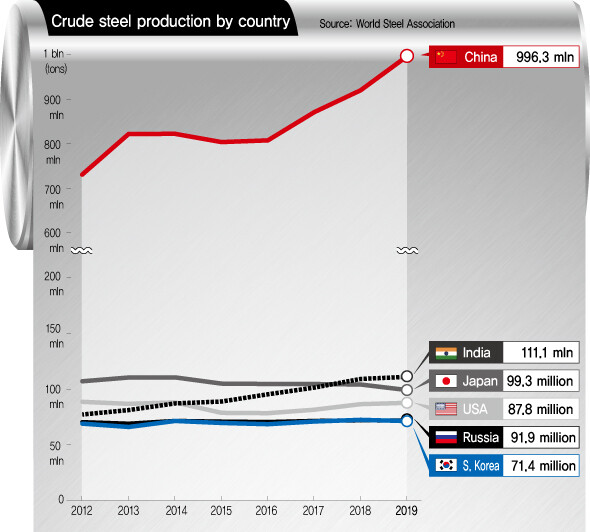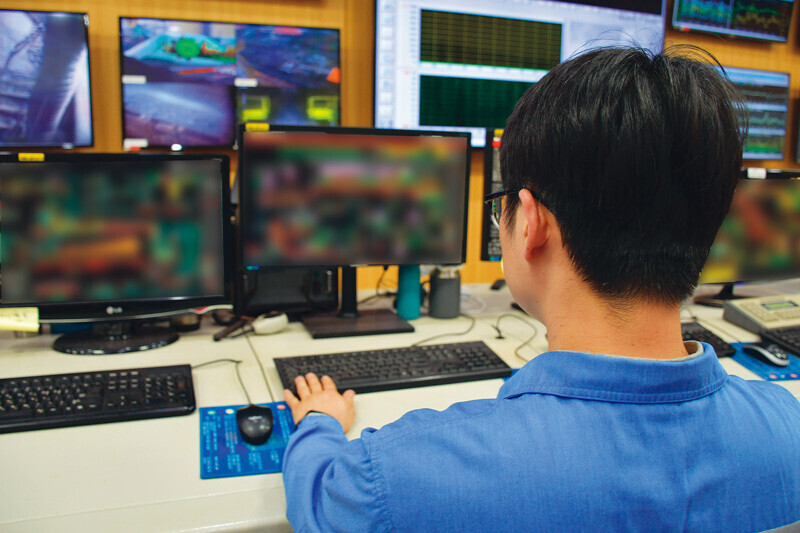hankyoreh
Links to other country sites 다른 나라 사이트 링크
[Reportage] Making steel in the digital era of AI

The Hankyoreh visited the operator’s room for the third sintering plant at POSCO’s steel works in Pohang, North Gyeongsang Province, on June 19. Normally so quiet that it is difficult to believe noisy machinery is operating outside, the room suddenly rang out with a warning siren. The exhaust gas temperature, the gas pipe pressure, the moisture content in the materials -- the eyes of section chief Nam Dong-hyeok, 37, moved busily as he watched the numbers changing in real time. Both the pressure and temperature were outside of normal range. The temperature had fallen from the range of 130-140°C to 128°C, while the pressure gauge pointed to around -19 kilopascals (kPa), or around 1 kPa below normal range. After looking over the numbers for a few minutes, Nam picked up his telephone and began shouting into it as he typed on his keyboard.
“There looks to be some problem with the moisture control system. Check it out.”
Nam explained, “If both the temperature and pressure are falling simultaneously, that usually means there isn’t enough moisture. But the artificial intelligence was saying the opposite -- that there was too much moisture, so it was reducing the moisture supply. I concluded there was something wrong.”
A worker on site measured the moisture content and found it to be fully 5% below normal range. The error in the AI’s conclusion had arisen because of a broken automatic moisture gauge that was transmitting the faulty value of 8%. Nam said, “We’re demanding system improvement measures so that the AI can detect errors when this kind of situation happens in the future.”

The third sintering plant visited by the Hankyoreh that day represents the last puzzle piece in POSCO’s effort over the past five years to establish a “smart factory.” The sintering plan heats iron ore and then crushes it into evenly sized particles of 20mm in diameter to send to the furnace. As the very first part of the process, it could fairly be said to determine the very quality of the final product. But in POSCO’s plan for smart factory adoption, it represented the very last step. Because of the large number of variables involved in the sintering process, the AI design is accordingly complex. POSCO began its smart factory effort in 2015 with relatively simple processes, starting with a steel plate factory at its Gwangyang steel works. The third sintering plant at the Pohang steel works was the first of the sintering plants to test-run AI last year; since 2020, it has been in official operation.
“I’ve basically been relearning the job since last year,” said Nam, explaining that his daily routine has undergone a complete transformation since the AI was adopted. In the past, the sintering machine -- with temperatures reaching 1300 degrees Celsius -- had a person standing right next to it monitoring it 24 hours a day and personally adjusting its speed. For this reason, it was essential to have a “commander” making accurate determinations.
That landscape is now gone, with AI having taken over that commander’s place. The AI controls the process based on around 750 indicators calculated in real time. In the past, data were gathered in intervals lasting as long as several hours; now a swifter response has been made possible. Workers in the factory now focus on managing and overseeing the AI system.

Some problems remain to be resolved. Early on after its adoption, the AI’s accuracy rate was just 60% -- meaning that it made the wrong determination four times out of ten. As a result, the development had to remain at the factory for the first six months to fix the system in real time.
Nam had another busy day that day. First the moisture measurement and control system was switched to manual, and the moisture gauge was sent in for repairs. The “fire” had been put out, but his work wasn’t over.
“The biggest problem is the malfunctioning moisture gauge, but it would be better if the AI understood the problems that can arise with the moisture when the temperature and pressure drop at the same time,” he said. Opinions on the group are passed along to the factory’s technology development section and the head office’s smart factory planning group. Through this process, the AI system’s accuracy has recently been boosted to the 90% level. Sintering factory director Choi Myeong-seok, 41, said the “target is to get it close to 100% accuracy.”
Another job is to train engineers who also know how to handle AI. Since 2017, POSCO has been offering work exemptions and full educational support benefits to employees who complete an AI specialist program at POSTECH. A total of 104 employees have received an education to date. Lee Jun-su, a 32-year-old deputy section chief, is one of them.
“I don’t think you can really develop a model that’s suited to the actual environment if you only understand AI and not the workplace situation,” Lee explained. “That thought is what made me decide to take the program.”

One of the factors behind POSCO’s smart factory effort has been what is happening in China. With observers estimating that China has more or less caught up with South Korea in technology terms, the only way to distinguish itself will be to lower production costs while making quality improvements. Indeed, POSCO’s investment of some 1.69 billion won (US$1.4 million) in turning the third sintering plant into a smart factory translated last year into a 2.3 billion-won (US$1.9 million) reduction in fuel costs compared with 2018.
“We anticipate being able to produce even better results going forward as the AI system’s accuracy and continuity with the process are improved,” a POSCO official said.
By Lee Jae-yeon, staff reporter
Please direct comments or questions to [english@hani.co.kr]

Editorial・opinion
![[Column] Life on our Trisolaris [Column] Life on our Trisolaris](https://flexible.img.hani.co.kr/flexible/normal/500/300/imgdb/original/2024/0505/4817148682278544.jpg) [Column] Life on our Trisolaris
[Column] Life on our Trisolaris![[Editorial] Penalties for airing allegations against Korea’s first lady endanger free press [Editorial] Penalties for airing allegations against Korea’s first lady endanger free press](https://flexible.img.hani.co.kr/flexible/normal/500/300/imgdb/original/2024/0502/1817146398095106.jpg) [Editorial] Penalties for airing allegations against Korea’s first lady endanger free press
[Editorial] Penalties for airing allegations against Korea’s first lady endanger free press- [Editorial] Yoon must halt procurement of SM-3 interceptor missiles
- [Guest essay] Maybe Korea’s rapid population decline is an opportunity, not a crisis
- [Column] Can Yoon steer diplomacy with Russia, China back on track?
- [Column] Season 2 of special prosecutor probe may be coming to Korea soon
- [Column] Park Geun-hye déjà vu in Yoon Suk-yeol
- [Editorial] New weight of N. Korea’s nuclear threats makes dialogue all the more urgent
- [Guest essay] The real reason Korea’s new right wants to dub Rhee a founding father
- [Column] ‘Choson’: Is it time we start referring to N. Korea in its own terms?
Most viewed articles
- 1New sex-ed guidelines forbid teaching about homosexuality
- 260% of young Koreans see no need to have kids after marriage
- 3Presidential office warns of veto in response to opposition passing special counsel probe act
- 4[Column] Life on our Trisolaris
- 5Months and months of overdue wages are pushing migrant workers in Korea into debt
- 6OECD upgrades Korea’s growth forecast from 2.2% to 2.6%
- 7S. Korea discusses participation in defense development with AUKUS alliance
- 8[Editorial] Penalties for airing allegations against Korea’s first lady endanger free press
- 9Opposition calling for thorough investigation into Pres. Park’s unelected power broker
- 10Ruling and opposition parties agree to special prosecutor for Pres. Park/Choi Sun-sil scandal